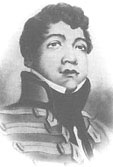Ka wai kau i ka maka ka ʻōpua
Hualalai kau mai i luna
Ka heke ia o na Kona
He ʻāina wela iʻo o na Kona
E ka makani ahe olu wai
ʻO ka pa konane ahe kehau
I ka ili o ka malihini
Hui:
Hanohano
ʻO Kona kai ʻōpua i ka laʻi
ʻO pua hinano i ka mālie
Wai na lai
Ka mako a ʻōpua
ʻAʻole no ahe lua aʻe like aku ia
Me Kona kai ʻōpua
Ke kai maʻokiʻoki
Ke kai malino aʻo Kona
Kona kai ʻōpua i ka laʻi
ʻO pua hinano i ka mālie
Holo na wai a ke kehau
Ke naʻu wai la nā kamaliʻi
Kāohi ana i ke kukuna lā
Kuʻu la kolili i kaʻili kai
Pumehana wale hoʻi ia ʻāina
Aloha no kini aʻo Hoʻolulu
ʻAʻohe lua ia ʻoe ke aloha
O kuʻu puni o ka mea ʻowa
Haʻina ka inoa o kuʻu lani
No Liholiho no ka inoa
Kahea: He Inoa No Liholiho

Kalaninui Liholiho, Kamehameha II
- Proud is Kona of Hawaii
- The waters and thick clouds
- Hualalai, the majestic mountain is high above
- Kona is the best
- This warm land
With the refreshing wind- The bright moonlight that
- Beckons the visitors
- Chorus:
- Proud
- The cloud banks over Kona's peaceful sea
- Like the hinano flower
- In the peaceful sea
- The cloudbanks of Kona
- Are incomparable, second to none
The cloudbanks of Kona- The streaked sea
- The peaceful sea of Kona
- The cloud bank over Kona's peaceful sea
- Like the hinano flower in the calm
- Where dusk descends with evening dew
- The na'u is chanted by the playful children
- Hold back the rays of the sun
- The sun rays reflecting on the surface of the sea
- Very warm is the land
- Very loving the Hoʻolulu progeny
- Nothing compares to the love
- O my beloved companion of all time
- For my lovely chief, my last refrain
- Liholiho, I praise your name
- The waters and thick clouds
- Call: The
Name Of Liholiho
- Source: Stanich Collection - This mele tells of a love affair between Liholiho (Kamehameha II) and a woman of rank. It sings of the places and activities of Kona and compares them to the deep emotions of love. Known as Kona of the tranquil seas, the ʻōpua or pink cumulus cloud formations that hang low, are regarded as omens of good fortune and good weather. Hinano is the blossom of the male pandanus tree and was used as an aphrodisiac. Naʻu is a game of Kona where the children chant "naʻu" and hold their breath until the sun disappears. Hoʻolulu was an ancient chief of Kona. Kalaninui Liholiho (Heaven's Great Glowing) was the child of Kamehameha I and Keopuolani, the most sacred and highest born of his wives. Trained to be king, he inherited the throne at an early age and co-ruled with Kaʻahumanu, the Kuhina Nui. Liholiho's third and favorite wife was Kamamalu, his half sister. Nov. 27, 1823, the King and Kamamalu boarded the English ship L'Aigle, the first of the Hawaiian Royals to travel abroad. This tragic state visit with King George of England was to gain political and commercial knowledge to better enable Liholiho to govern his kingdom that had attracted many foreigners. When the royal party arrived in England 6 months later, it was discovered that more that half of the $25,000 they carried had been stolen. Before they had an audience with the English Monarch, the Hawaiians were struck with measles. Queen Kamamalu died July 8, 1824 followed by the death of King Liholiho, July 14. Like all Hawaiians, they had no immunity to diseases.